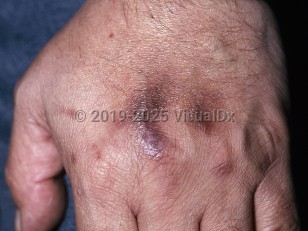Drug-induced pigmentation in Adult
Alerts and Notices
Important News & Links
Synopsis

Increased melanin most often produces a brownish pigmentation in the dermis. When active compounds deposit in the dermis, however, there may be associated red-brown, blue-black, blue-gray, purple, or slate discoloration.
There are certain classes of drugs that are more commonly implicated in causing skin, mucous membrane, and nail pigmentation. These include antimalarials, some antimicrobials, heavy metals, antineoplastic (chemotherapeutic) agents, and psychotropics and anticonvulsants. NSAIDs and antiretrovirals have also been noted as causing specific pigment changes. Chronic use of kratom, an opioid-like supplement available over the counter, has been associated with photodistributed hyperpigmentation, often of the face and hands.
Related topics: drug-induced flagellate pigmentation, amiodarone drug-induced pigmentation, minocycline drug-induced pigmentation, drug-induced hypopigmentation, drug-induced oral pigmentation, drug-induced nail pigment, fixed drug eruption
Codes
L81.9 – Disorder of pigmentation, unspecified
T50.905A – Adverse effect of unspecified drugs, medicaments and biological substances, initial encounter
SNOMEDCT:
110284009 – Drug-induced pigmentation
Look For
Subscription Required
Diagnostic Pearls
Subscription Required
Differential Diagnosis & Pitfalls

Subscription Required
Best Tests
Subscription Required
Management Pearls
Subscription Required
Therapy
Subscription Required
Drug Reaction Data
Subscription Required
References
Subscription Required
Last Updated:06/30/2024

